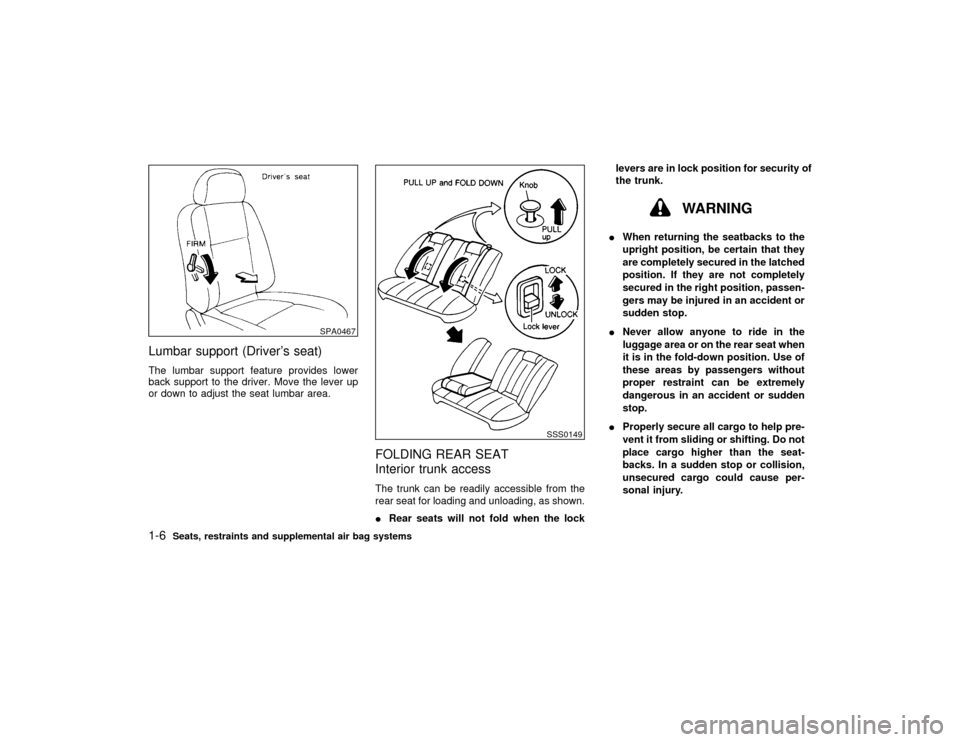NISSAN MAXIMA 2000 A33 / 5.G User Guide
Manufacturer: NISSAN, Model Year: 2000, Model line: MAXIMA, Model: NISSAN MAXIMA 2000 A33 / 5.GPages: 239, PDF Size: 1.97 MB
Page 11 of 239

Lumbar support (Driver's seat)The lumbar support feature provides lower
back support to the driver. Move the lever up
or down to adjust the seat lumbar area.
FOLDING REAR SEAT
Interior trunk accessThe trunk can be readily accessible from the
rear seat for loading and unloading, as shown.
IRear seats will not fold when the locklevers are in lock position for security of
the trunk.
WARNING
IWhen returning the seatbacks to the
upright position, be certain that they
are completely secured in the latched
position. If they are not completely
secured in the right position, passen-
gers may be injured in an accident or
sudden stop.
INever allow anyone to ride in the
luggage area or on the rear seat when
it is in the fold-down position. Use of
these areas by passengers without
proper restraint can be extremely
dangerous in an accident or sudden
stop.
IProperly secure all cargo to help pre-
vent it from sliding or shifting. Do not
place cargo higher than the seat-
backs. In a sudden stop or collision,
unsecured cargo could cause per-
sonal injury.
SPA0467
SSS0149
1-6
Seats, restraints and supplemental air bag systems
Z
00.1.17/A33-D/V5.0
X
Page 12 of 239

IClosely supervise children when they
are around cars to prevent them from
playing and becoming locked in the
trunk where they could be seriously
injured. Keep the car locked with the
rear seatback securely latched when
not in use, and prevent children's
access to car keys.
HEAD RESTRAINT ADJUSTMENTTo raise the head restraint, just pull it up. To
lower, push the lock knob and push the head
restraint down.
WARNING
Head restraints should be adjusted
properly as they may provide significant
protection against injury in an accident.
Do not remove them. Check the adjust-ment after someone else uses the seat.
SSS0125Seats, restraints and supplemental air bag systems
1-7
Z
00.1.17/A33-D/V5.0
X
Page 13 of 239

Adjust the head restraints so the top is level
with the top of your ears.
ARMRESTPull the armrest forward until it is horizontal.
PRECAUTIONS ON
SUPPLEMENTAL RESTRAINT
SYSTEMThis Supplemental Restraint System (SRS)
section contains important information con-
cerning the driver and passenger supplemen-
tal air bags, supplemental side air bags and
pre-tensioner seat belts.
Supplemental front air bag system:This
system can help cushion the impact force to
the face and chest of the driver and front
passenger in certain frontal collisions.
Supplemental side air bag system (if so
equipped):This system can help cushion the
impact force to the head and the chest area of
the driver and front passenger in certain side
impact collisions. The supplemental side air
bag is designed to inflate on the side where the
vehicle is impacted.
These supplemental restraint systems are de-
signed tosupplementthe crash protection
provided by the driver and front passenger
seat belts and arenot a substitutefor them.
Seat belts should always be correctly worn
and the driver and front passenger seated a
suitable distance away from the steering
wheel, instrument panel and front door finish-
ers. (See ªSeat beltsº later in this section for
SSS0164
SSS0150
SUPPLEMENTAL RESTRAINT
SYSTEM
1-8
Seats, restraints and supplemental air bag systems
Z
00.1.17/A33-D/V5.0
X
Page 14 of 239

instructions and precautions on seat belt us-
age.)
After turning the ignition key to the ON
position, the supplemental air bag warning
light illuminates. The supplemental air bag
warning light will turn off after about 7
seconds if the system is operational.
WARNING
IThe supplemental front air bags ordi-
narily will not inflate in the event of a
side impact, rear impact, roll over, or
lower severity frontal collision. Al-
ways wear your seat belts to help
reduce the risk or severity of injury in
various kinds of accidents.
IThe seat belts and the supplemental
front air bags are most effective whenyou are sitting well back and upright
in the seat. Front air bags inflate with
great force. If you are unrestrained,
leaning forward, sitting sideways or
out of position in any way, you are at
greater risk of injury or death in a
crash and may also receive serious
or fatal injuries from the supplemen-
tal front air bag if you are up against
it when it inflates. Always sit back
against the seatback and as far away
as practical from the steering
SSS0131
Seats, restraints and supplemental air bag systems
1-9
Z
00.1.17/A33-D/V5.0
X
Page 15 of 239

wheel or instrument panel. Always
use the seat belts.
IKeep hands on the outside of the
steering wheel. Placing them inside
the steering wheel rim could increase
the risk that they are injured when the
supplemental front air bag inflates.
SSS0132
1-10
Seats, restraints and supplemental air bag systems
Z
00.1.17/A33-D/V5.0
X
Page 16 of 239

SSS0006SSS0007
SSS0008SSS0009
SSS0099SSS0100
Seats, restraints and supplemental air bag systems
1-11
Z
00.1.17/A33-D/V5.0
X
Page 17 of 239

WARNING
INever let children ride unrestrained
or extend their hands or face out of
the window. Do not attempt to hold
them in your lap or arms. Some ex-
amples of dangerous riding positions
are shown in the previous illustra-
tions.
IChildren may be severely injured or
killed when the supplemental front air
bag or supplemental side air bag in-
flates if they are not properly re-
strained.
IAlso never install a rear facing child
restraint in the front seat. An inflating
supplemental front air bag could se-
riously injure or kill your child. For
additional information, see ªChild re-
straintsº later in this section.
WARNING
Supplemental side air bag (if so
equipped):
IThe supplemental side air bag ordi-
narily will not inflate in the event of a
frontal impact, rear impact or lower
severity side collision. Always wear
your seat belts to help reduce the risk
or severity of injury in various kinds
of accidents.IThe seat belts and the supplemental
side air bag are most effective when
you are sitting well back and upright
in the seat. The side air bag inflates
with great force. Do not allow anyone
to place their hand, leg or face near
the side air bag on the side of the
seatback of the front seat. Do not
allow anyone sitting in the front seat
to extend their hand out of the win-
dow or lean against the door. Some
examples of dangerous riding posi-
tions are shown in the previous illus-
SSS0101
SSS0140
1-12
Seats, restraints and supplemental air bag systems
Z
00.1.17/A33-D/V5.0
X
Page 18 of 239

trations.
IWhen sitting in the rear seat, do not
hold onto the seatback of the front
seat. If the supplemental side air bag
inflates, the occupant may be seri-
ously injured. Be especially careful
with children, who should always be
properly restrained.
IDo not use seat covers on the front
seatbacks. They may interfere with
supplemental side air bag inflation.
SSS0159
SSS0162Seats, restraints and supplemental air bag systems
1-13
Z
00.1.17/A33-D/V5.0
X
Page 19 of 239

Supplemental front air bag systemThe driver supplemental air bag is located in
the center of the steering wheel; the front
passenger supplemental air bag is mounted in
the dashboard above the glove box. These
systems are designed to meet optional certifi-
cation requirements under U.S. regulations.
They are also permitted in Canada. The op-
tional certification allows front air bags to be
designed to inflate somewhat less forcefully
than previously.However, all of the informa-
tion, cautions and warnings in this manual
still apply and must be followed.The front
air bags are designed to inflate in higherseverity frontal collisions, although they may
inflate if the forces in another type of collision
are similar to those of a higher severity frontal
impact. They may not inflate in certain frontal
collisions. Vehicle damage (or lack of it) is not
always an indication of proper supplemental
air bag operation.
When the supplemental front air bag inflates, a
fairly loud noise may be heard, followed by
release of smoke. This smoke is not harmful
and does not indicate a fire, but care should be
taken not to inhale it, as it may cause irritation
and choking. Those with a history of a breath-
ing condition should get fresh air promptly.Supplemental front air bags along with the use
of seat belts, helps to cushion the impact force
on the face and chest of the front occupants.
They can help save lives and reduce serious
injuries. However, an inflating front air bag
may cause facial abrasions or other injuries.
Front air bags and supplemental side air bags
do not provide restraint to the lower body.
The seat belts should be correctly worn and
the driver and passenger seated upright as far
as practical away from the steering wheel or
dash board. Since the supplemental front air
bags inflates quickly in order to help protect
the front occupants, the force of the front air
bag inflating can increase the risk of injury if
the occupant is too close to or is against the air
bag module during inflation. The air bag will
deflate quickly after the collision is over.
After turning the ignition key to the ON
position, the supplemental air bag warning
light illuminates. The supplemental air bag
warning light will turn off after about 7
seconds if the system is operational.
SSS0151B
1-14
Seats, restraints and supplemental air bag systems
Z
00.1.17/A33-D/V5.0
X
Page 20 of 239

WARNING
IDo not place any objects on the steer-
ing wheel pad or on the instrument
panel. Also, do not place any objects
between any occupant and the steer-
ing wheel or instrument panel. Such
objects may become dangerous pro-
jectiles and cause injury if the supple-
mental front air bag inflates.
IRight after inflation, several air bag
system components will be hot. Do
not touch them; you may severely
burn yourself.
INo unauthorized changes should be
made to any components or wiring of
the supplemental front air bag sys-
tem. This is to prevent accidental
inflation of the air bag or damage to
the air bag system.
IDo not make unauthorized changes
to your vehicle's electrical system,
suspension system or front end
structure. This could affect properoperation of the supplemental air bag
system.
ITampering with the supplemental
front air bag system may result in
serious personal injury. Tampering
includes changes to the steering
wheel and the instrument panel as-
sembly by placing material over the
steering wheel pad, above the dash-
board, or by installing additional trim
material around the air bag system.
IWork around and on the supplemen-
tal front air bag system should be
done by an authorized NISSAN
dealer. Installation of electrical equip-
ment should also be done by an au-
thorized NISSAN dealer. The SRS wir-
ing harnesses* should not be
modified or disconnected. Unautho-
rized electrical test equipment and
probing devices should not be used
on the air bag system.
* The SRS wiring harnesses are cov-
ered with yellow insulation either justbefore the harness connectors or
over the complete harness for easy
identification.
When selling your vehicle, we request that you
inform the buyer about the supplemental front
air bag system and guide the buyer to the
appropriate sections in this Owner's Manual.
Seats, restraints and supplemental air bag systems
1-15
Z
00.1.17/A33-D/V5.0
X